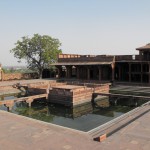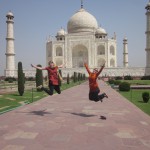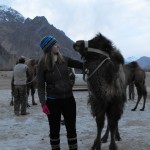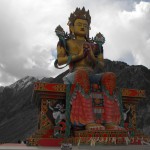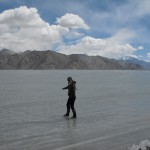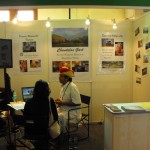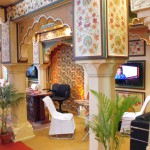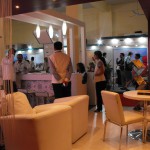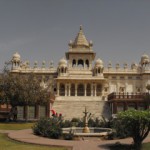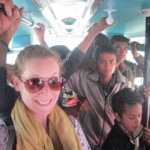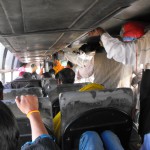Agra… A trashy city, but one of the most visited cities in the entire world. Placed in Agra are the most popular monuments and structures from the Moghul empire that was the ruling class of India from the 1400’s to the 1700’s. The Taj Mahal and the Agra Fort are the most popular tourists attractions of this area, and of India in general.
Let me start from the beginning. After a week of freezing our little asses off in Leh, Emily and myself arrived in Delhi to part ways with Radhika and Nibha who were off to their respective homes. However, Emily and I were not off to our home in and around Jodhpur, we were going to make our mark on Indian history by visiting the Taj Mahal in Agra. Not only was that our plan, but also Emily’s brother, Ryan, had arrived the night before in Delhi and we had to pick him up at his hotel on the way to the train station to take us to our destination. This proved more difficult than expected.
After arriving to the station in New Delhi, we easily found our train, being the train-riding veterans that we are, but the problem was that there was a family that was in the same berth that we were assigned to when we got on the train. Well, after sitting down they asked for our ticket and while, yes, they were in the same berth we had been assigned to; our train tickets were booked for the wrong day! Thanks a lot to the travel agent who booked our tickets because the online retail site was not working… But thank the heavens that they were the nicest family and said we could share the berth with them for the 3 plus hour ride to Agra where we departing. It was quite fun as the family shared their snacks with us, and Ryan got his first taste of true Indian hospitality and culture with the family on the train.
After arriving in Agra, the first thing we did was take a cab to Fatehpur Sikri, a city founded by Emperor Akbar in the late 1500’s that was only lived in for 15 years and was abandoned after the emperor died due to lack of water availability. The biggest draw to Fatehpur Sikri for tourists is to see the city but also to see the different homes inside the city walls that were built specifically for each of Akbar’s wives. He had three wives: one Hindu from North India, one Muslim from Turkey, and one Christian from South India. The wives were apparently very important to Akbar and he built each one a specific and decorative home to show his adoration. It was apparent which was his favorite after touring through each of the wives homes… The Hindu wife was given an entire complex ornately decorated with imported turquoise and marble and had a giant courtyard in the middle while the others were given significantly smaller but more intricately decorated homes.
Of course when we decided to see the most visited part of the abandoned city is when the touts started to seek out our attention, most likely because it is the area that does not require a ticket fee and hold the mosque that is still visited by many passerby’s and locals alike. Once inside the area, a man who “claimed” he was not looking for any incentive, decided to talk to us about the area and take us around to the different areas of the mosque and outlying areas. After we walked around, and listened to his most likely only half correct account of the history, he took us to an area that houses an artisan that displayed his work of stone that looked undistinguishable from all the other vendors in the area. Well, our guide said it was his work and that he came from a family of stone workers and that they had personally made all of the products for sale. Yeah right, we know better than that, and after telling him that we did not ask him for his services and refusing his tout for business, we walked our way out of Fatehpur Sikri.
After spending the better part of the day wandering around the amazingly beautiful piece of Moghul architechural history that Fatehpur Sikri is, we made our way back to Agra to check into our hotel, enjoy a rest and cocktail, then make it to dinner for the night. The plan for the next day was to get up at the crack of dawn and make it to the Taj Mahal for when they first opened in order to see it in the soft morning hues that would lightly reflect the violets and saffron orange as the sun slowly rose from the eastern horizon. However, that never happened seeing as how we were so tired and didn’t feel like arising the to the non-existent smell of fresh roasted coffee and crackling bacon. Instead we slept in for a while and decided to wake up when we felt like it which was closer to 9 a.m. After breakfast we then decided it would be time to visit one of the most visited sites in the world.
The Taj Mahal; very impressive but not all it cracked up to be. Granted being able to build an architectural beauty that has no flaws in the building using marble and whitewashed sandstone is an amazing feat in the 1400’s but so are so many of the fort and palaces of Rajasthan… I thought it was an amazing shrine that was built for one person, especially a wife of a Moghul emperor whose society said a woman was not worth more than a child-bearer, but it was not the first or last marvelous building to be seen in India. However, I had a real problem when walking around inside the shrine built for the favorite wife of Emperor whatever when we were cowering in a small hallway from the huge crowd surrounding us and we noticed a defamation of the edifice. Indian teens and youngsters had written all over the walls with “I love so-and-so” and “Me plus Him” and what ever else they decided would be worthy to WRITE and SCRATCH into the walls of a UNESCO and astonishing world heritage site. Why on earth wouldn’t these young people understand the value of the freaking Taj Mahal? That is because most of the people in India are no longer taught the value of beauty and understanding of their culture and are slowly loosing site of whom and what their country once was.
I have found that most Indians feel that what is not theirs does not matter. It is only education that can reverse that into a mentality that will once again restore grandeur and reverence this wonderful country once held. Other than that though, the city itself was one of the worst cities I have visited in the country due to the influx of tourists, which causes people to only care about what they can get from the tourists and not how the experiences are for those people. Agra… Not the best experience in India but definitely a must when visiting this imperial empire of one time.
